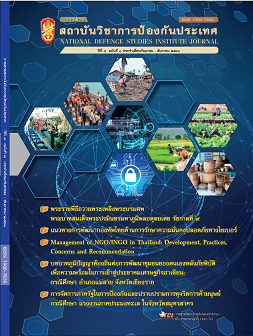ความร่วมมือระหว่างภาครัฐและเอกชนในการพัฒนาแรงงาน กรณีศึกษา ด้านการเขียนแบบและผลิตด้วยโปรแกรมคอมพิวเตอร์ในการผลิต
Main Article Content
Abstract
บทคัดย่อ
การศึกษาวิจัยครั้งนี้ผสมระหว่างการวิจัยเชิงคุณภาพและเชิงปริมาณ วัตถุประสงค์ของการวิจัยเพื่อศึกษาปัจจัย ความร่วมมือระหว่างภาครัฐกับภาคเอกชนเกี่ยวกับการพัฒนาแรงงานโดยเฉพาะอย่างยิ่ง "การเขียนแบบและการผลิตโดยใช้โปรแกรมคอมพิวเตอร์ และเพื่อศึกษาปัญหาและอุปสรรคต่างๆ ที่เกิดจากความร่วมมือของภาครัฐและเอกชนสำหรับการวิจัยเชิงคุณภาพนั้น ข้อมูลที่ต้องการได้มาจากเอกสาร และการสัมภาษณ์แบบเจาะลึกกับผู้ให้ข้อมูล 14 ท่าน เครื่องมือที่ใช้ในการเก็บข้อมูลเชิงปริมาณ ได้แก่ แบบสัมภาษณ์กึ่งโครงสร้างโดยใช้การวิเคราะห์เนื้อหา การวิเคราะห์เชิงพรรณนาร่วมกับการวิเคราะห์สามเส้าเชิงข้อมูลด้วยส่วนการวิจัยเชิงปริมาณนั้น กลุ่มตัวอย่างของการวิจัยเชิงปริมาณคือนักศึกษาอาชีวศึกษา ด้วยการสุ่มตัวอย่างโดยไม่คำนึงถึงความน่าจะเป็น เครื่องมือที่ใช้เก็บข้อมูลเชิงปริมาณ ก็คือ แบบสอบถามซึ่งวิเคราะห์โดยใช้สถิติพรรณนา (ความถี่ ค่าเฉลี่ย และส่วนเบี่ยงเบนมาตรฐาน)
จากการวิเคราะห์ข้อมูลเชิงคุณภาพประเด็นสำคัญพบว่าสาเหตุของความขาดแคลนได้แก่ ความล้มเหลวไม่ต่อเนื่องและความขัดแย้งในการนำนโยบายไปปฏิบัติ งบประมาณมีไม่เพียงพอ ถึงแม้รัฐมีนโยบายลดหย่อนภาษี ภาพลักษณ์ในทางลบของนักศึกษาอาชีวศึกษา ขาดความพร้อมในการสอนและด้านเทคโนโลยี สิ่งที่ค้นพบจากการวิจัยเชิงปริมาณมีประเด็นหลักดังนี้ นักศึกษาส่วนใหญ่ตัดสินใจด้วยตัวเองในการเลือกเรียน ที่สำคัญก็คือ เนื้อหาสาระของรายวิชาน่าสนใจ และครูผู้สอนตลอดจนอาจารย์แนะแนวก็มีประสบการณ์ในการสอนและแนะแนว ผู้ปกครองส่งเสริมให้เลือกเรียนตามความต้องการ ผลการวิเคราะห์ข้อมูลเชิงปริมาณและเชิงคุณภาพ สามารถให้ข้อเสนอแนะ ดังต่อไปนี้ควรมุ่งเน้นไปในเรื่องที่ปฏิบัติได้จริง ภาครัฐและภาคเอกชนจะต้องให้ความช่วยเหลือ สนับสนุน ในด้านงบประมาณเพื่อการฝึกอบรม
คำสำคัญ: ความร่วมมือ/การพัฒนาแรงงาน/การเขียนแบบด้วยโปรแกรมคอมพิวเตอร์ในการผลิต/การผลิตด้วยโปรแกรมคอมพิวเตอร์ในการผลิต
Abstract
The study was mixed in character – the qualitative and the quantitative methods. The main objectives of the study of factors, investigate the cooperation between the public sector and the private sector with regard to the labor development particularly computer-aided designing and computer-aided manufacturing; and to ascertain the difficulties and obstacles springing from the cooperation between the two sectors. The required information is derived from the document by In-depth interviews with 14 respondents. Quantitative tools were semi-structured interviews using content analysis and the data triangle. Quantitative research is Quantitative research samples are vocational students by sampling irrespective of probability. Quantitative data collection tools were questionnaires, which were analyzed using descriptive statistics (mean frequency and standard deviation).
From the analysis of qualitative data, it was found that the causes of the shortage were discontinuity and conflict of policy implementation. Budget is not enough, although the state has a tax reduction policy, negative image of vocational students, lack of teaching and technology. The results from quantitative research are as follows: Most students decide for themselves to choose a course. The key is the content of the course is interesting. And teachers and counselors are experienced in teaching and counseling. Parents are encouraged to choose the required course. Quantitative and qualitative data analysis results are the following suggestions should focus on practical issues. Public and private sectors must provide financial support for training.
Keywords: Cooperation / Workforce Development / Computer Aided Designing (CAD)/ Computer Aided Manufacturing (CAM)
Article Details
The articles, images, tables, graphs, written content, and opinions published in this journal are solely those of the authors and do not necessarily reflect the views or positions of the National Defence Studies Institute or its academic affiliates.


